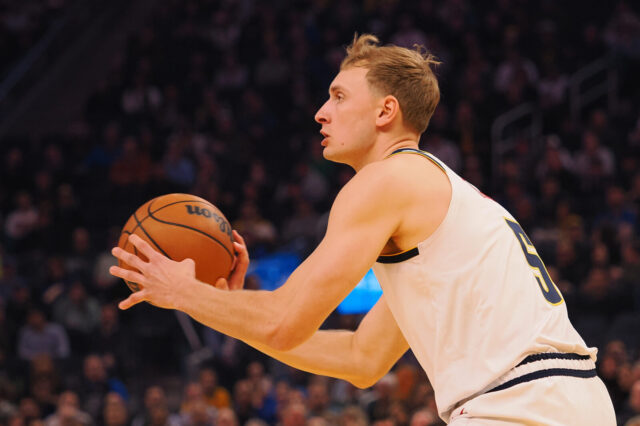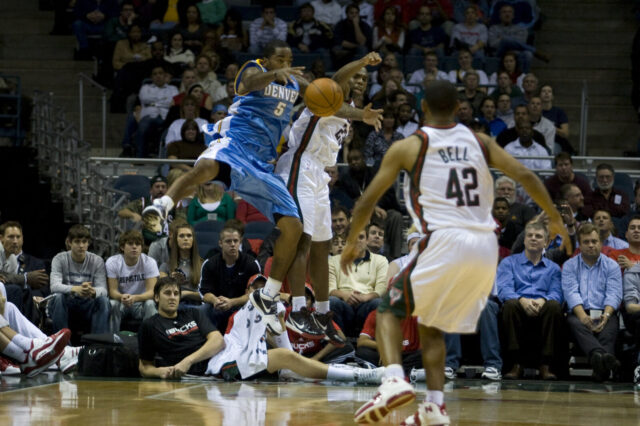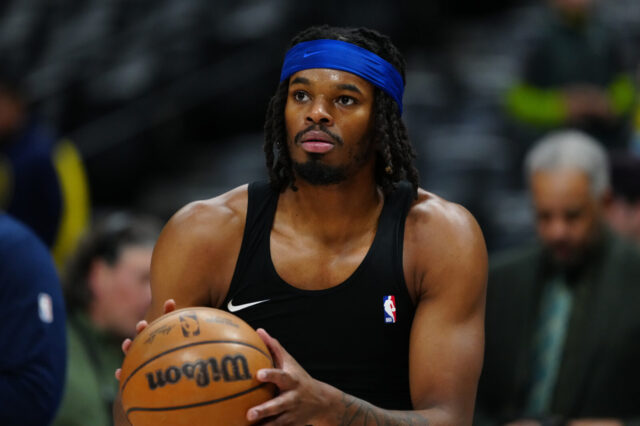The Denver Nuggets have dealt with a litany of injuries this season, and none have been more impactful than those to Gary Harris and Will Barton.
While the Nuggets have played 79 games this year, Harris has suited up for just 54 of them, and Barton has played in just 40. It’s difficult to develop a rhythm when one is in and out of the lineup as much as Harris has been, while both he and Barton have struggled to fully recover athletically. This has manifested in a variety of ways, most notably finishing on two-pointers.
This content is no longer available.
This has affected each guy in their own way. This season, the proportion of twos Harris has taken has increased from .59 to .609, mostly because his three-point shot has also waxed and waned slightly. Shooting 34.2 percent from beyond the arc this year, Harris hasn’t been quite the knockdown shooter of recent years either. Teams still respect him as an outside shooter though, and by going over the screen on handoffs and ball screens, Harris has been enticed into taking a number of floaters this year.
He hasn’t hit them with enough regularity though. As I wrote about in Stat of the Week on Wednesday, the floater area hasn’t been one of Harris’ strong suits. Harris has shot just 31.5 percent from the field on shots in floater range (3-10 feet) which ranks 131st out of 142 players to attempt as many such shots.
It has to be a quality part of his game though, because Harris doesn’t generate nearly as many shots directly at the rim as he has in previous seasons. Only 28 percent of Harris’ shots come from within 0-3 feet, and he’s making those at a career low rate of 60.4 percent (outside of his rookie year).
Harris’ injuries have manifested in his ability to generate these high quality looks both in the half court and in transition.
Transition finishes were a staple of Harris’ game for a long time, racing up the court off of outlet passes from Nikola Jokic, finishing over the outstretched arms of a helpless opposition. Last year, Harris scored 1.27 points per possession in transition plays. This season, he’s down to 0.95 PPP, meaning the Nuggets would be better off working a possession in the half court.
Then there’s Barton, whose slithery style in the pick and roll make him a dangerous finisher when he’s on his game.
But while Harris’ injury simply seems to have taken some lift off his shooting, Barton’s injury has changed his game. Barton has settled for more perimeter jumpers than ever before, clearly affected by the groin injury that stole half of his season away. Already possessing a slender frame and the maneuverability to avoid contact on drives, Denver’s starting small forward hasn’t gone to the free throw line quite as much as one would hope for a ball handler. Among all players with 1,000 minutes played and averaging greater than 5.0 assists per 100 possessions, Barton is in the 16th percentile in free throw rate, right in between Patty Mills and Nicolas Batum. By comparison, last year’s number would have put him in between Evan Turner and Stephen Curry, much more competent foul-drawers.
Barton’s game has become less about creating contact and more about avoiding it. Here, he has an opportunity to get into Wesley Matthews and draw the foul on an isolation layup. Instead, he tries a driving floater over the smaller defender that just rolls off the rim. This is the perfect scenario to try and create some contact after an excellent move to get him some space, but Barton settles for the lower percentage look.
At another point in time, Barton would have attempted to slash through the seam of the defense here and either finish through contact at the rim or kick out to the strong side corner. Instead, he settles for the 18-footer, a decent shot with the shot clock winding down but certainly not one the offense is designed to generate. Barton is in the 29th percentile on what I would classify mid range jump shots this year, so one would prefer to see him at the free throw line or trying to finish through contact instead.
In addition, Barton has struggled defensively post All-Star break, averaging just 0.425 steals per game and holding his defensive matchup to +3.7% difference between field goal percentage allowed and average field goal percentage. That’s one of the weaker marks in the NBA. The list of players to average under 0.5 steals per game as a guard is pretty paltry. It’s JJ Redick, Will Barton, and that’s it. That’s not great defensive company to hold, and the eye test paints a similar picture.
Giving Kevin Durant ample space to take a mid range jumper is a bad sign, and Barton gives him a country mile.
Here, Barton gets turned around multiple times, unable to stay with Durant who generates a three with solid off-ball movement. Defending the three against the Warriors is of paramount importance, and the Nuggets, who were within 7 points on the above play, needed a better contest on that kind of shot late in the clock. It’s a hard ask to guard Kevin Durant, but Barton is the best option if the Nuggets match up with the Warriors, and Durant went 9/13 from the field while matched up almost exclusively with Barton. That can’t happen if the Nuggets want to win the game.
The Nuggets are resting Nikola Jokic, Paul Millsap, and Jamal Murray tonight against the Portland Trail Blazers. That isn’t necessarily a determination on who Denver’s best players are, but Jokic, Millsap, and Murray have carried the load for Denver while Harris and Barton have tried to find their groove. Now, with those guys sitting, it’s time for Harris and Barton to kick their games into overdrive and work on how to impact the starting lineup in the best possible way. From handling the ball, to spacing the floor, to defending the other team’s best guard scorers, the Nuggets need Harris and Barton to be at their best come playoff time.
With Denver likely using a nine man rotation that includes Torrey Craig playing some power forward in the playoffs, Harris and Barton are Denver’s primary outside shooters for most of the game. The best way those two can impact the game is by hitting multiple threes in a game on efficient percentages. In the last 10 games, the two starting wings are shooting 36.8 and 32.6 percent respectively. The first number is reasonable, but the second isn’t so great.
In the playoffs, the Nuggets will need as much spacing around Murray-Jokic two-man actions or Jokic/Millsap 1-on-1 possessions. If Denver can’t get enough spacing in those situations out of Harris and Barton, the most logical option is to find another player who will hit those shots. Both Monte Morris and Malik Beasley have shown a propensity to do so, and that may be an important countermove for the Nuggets if the proper spacing isn’t generated.
Denver can hit its ceiling this year, a Western Conference Finals appearance, only if Harris and Barton are good enough to stay on the floor and provide the other things they are great at. Harris has been a great defender this season. Barton provides another pick and roll option next to Jokic, especially when Murray is struggling. When everything comes together, the five-man unit of Murray, Harris, Barton, Millsap, and Jokic is still one of the best five-man units in the NBA.
But the playoffs are fickle, and the Nuggets will be a prisoner of the moment if they don’t get the performances out of Harris and Barton that they need to survive. The difference between advancing and falling in the first round could be how those two perform outside of the other three core players. Everybody on the roster has questions outside of Millsap, but it’s unclear where the answers are for some guys.
Hopefully, Gary Harris and Will Barton are the first to answer the call.


